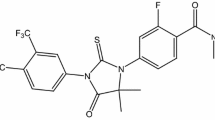Summary
Hexamethylenebisacetamide (HMBA), an in vitro differentiating agent, was studied for its pharmaco-dynamic actions in animals. Plasma stability, organ distribution, excretion, oral bioavailability, and estimates of pharmacokinetic parameters and acute lethality were determined in rats. The single dose intraperitoneal LD50 was greater than 3000 mg/kg in both mice and rats. The drug was stable in plasma from several different species during an 8 h in vitro incubation at 37°C. Following a single intravenous (iv) bolus injection (1000 mg/kg) to rats, HMBA was removed from the plasma with a half time of 2.2 ± 0.5 h, and 65 ± 8% of the dose was excreted unchanged in the urine during the first 24 h after dosing. During an 8 h iv infusion, plasma concentrations of 4 mM were easily maintained with no apparent adverse effects. Drug was uniformly distributed, with highest concentrations found in thymus, kidney, liver, and lymph node throughout the first 24 h after a single iv bolus dose. In vivo metabolism was very small, and the presence of apparent metabolites was undetectable until 48 h after iv administration. Oral bioavailability was good (32%), with peak plasma concentrations of 2 mM achieved one hour after oral administration. After oral dosing urinary excretion and plasma decay were comparable to similar data obtained after iv dosing.
Similar content being viewed by others
References
Friend C, Scher W, Holland JG, Sato T: Hemoglobin synthesis in murine virus-induced leukemic cells in vitro: Stimulation of erythroid differentiation by dimethyl sulfoxide. Proc Natl Acad Sci USA 68:378–382, 1971
Tanaka M, Levy J, Terada M, Breslow R, Rifkind RA, Marks PA: Induction of erythroid differentiation in murine virus infected erythroleukemia cells by highly polar compounds. Proc Nat Acad Sci USA 72:1003–1006, 1975
Marks PA, Reuben R, Epner E, Breslow R, Cobb W, Bogden AE, Rifkind RA: Induction of murine erythroleukemia cells to differentiate: A model for the detection of new antitumor drugs. Antibiotics Chemother 23:33–41, 1978
Reuben RC, Wife RL, Breslow R, Rifkind RA, Marks PA: A new group of potent inducers of differentiation in murine erythroleukemia cells. Proc Natl Acad Sci USA 73:862–866, 1976
Reuben RC, Rifkind RA, Marks PA: Chemically induced murine erythroleukemic differentiation. Biochim Biophys Acta 605:325–346, 1980
Fibach E, Reuben RC, Rifkind RA, Marks PA: Effect of hexamethylene bisacetamide on the commitment to differentiation of murine erythroleukemia cells. Cancer Res 37:440–444, 1977
Lichtfield JT, Wilcoxon F: A simplified method of evaluating dose-effect experiments. J Pharmacol Exper Therap 96:99–106, 1949
Knott GD: MLAB — a mathematical modeling tool. Comput Prog Biomed Res 10:271–280, 1981
Gibaldi M and Perrier D: Pharmacokinetics. Marcel Dekker, NY, 1975
Author information
Authors and Affiliations
Rights and permissions
About this article
Cite this article
Litterst, C.L., Roth, J.S. & Kelley, J.A. Distribution, elimination, metabolism and bioavailability of hexamethylenebisacetamide in rats. Invest New Drugs 3, 263–272 (1985). https://doi.org/10.1007/BF00179430
Issue Date:
DOI: https://doi.org/10.1007/BF00179430




